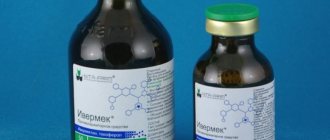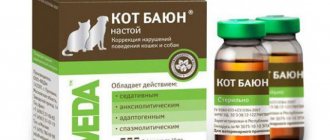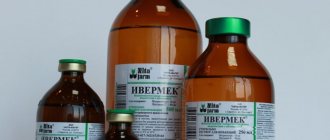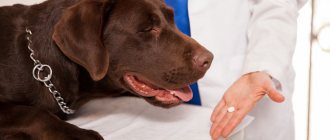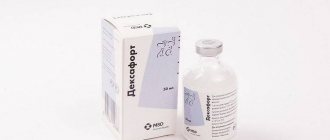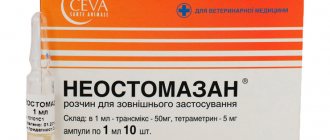Ivermec is a controversial antiparasitic drug. Some dog owners praise it as the most effective treatment for ticks, while others report many side effects, including deaths.
Both are right: the drug copes well with parasitic infestations, but at the same time, it is toxic.
From the article you will learn: how dangerous Ivermek is for animals and people, when it should be prescribed, and in which cases it is better to prefer safer drugs, how to use the medication and which breeds it is strictly prohibited.
At the end of the review you will find analogues, tips on use and preventing negative reactions.
The information is current as of January 2022 and is constantly updated.
Release form and composition
Ivermek for dogs (Ivermek) is a Russian-made antiparasitic agent. It is produced by Russian.
The main active ingredient of Ivermec is ivermectin. The drug is produced in 3 forms: solution, spray and gel.
The solution is produced in 2 variations: the usual one for intramuscular injections and Ivermek ON for treatment from a sprayer. It is usually prescribed to farm animals. It is rarely used for dogs, but sometimes they give injections with medication or drink it.
The components and their content in each form of the drug are different.
| Solution | Spray | Gel |
| Ivermectin (10 mg/1 ml) | Ivermectin (2.5 mg/1 ml) | Ivermectin (1.0 mg/1 ml) |
| Vitamin E (40 mg/1 ml) | Lidocaine (20 mg/1 ml) | Lidocaine (50 mg/1 ml) |
| Excipients | Chlorhexidine (0.5 mg/1 ml) | Panthenol (15 mg/1 ml) |
| Dexpanthenol (10 mg/1 ml) | Excipients | |
| Additional components |
A 30 ml tube of gel costs on average 430 rubles, a spray bottle of the same volume costs 380 rubles. Price for 50 ml of solution – 260 rubles.
We recommend reading our review of 20 drops against fleas and ticks at the link.
Storage conditions
The drug should be stored in well-closed packaging, in dry places protected from light and moisture. The product must be inaccessible to small children and pets. The medicine does not lose its properties if it is kept in temperature conditions of 0-25°C. The shelf life of this product is 2 years, counted from the date of its release. After opening the bottle, the injection solution must be used within 3 weeks. In the following days, the medicine loses its antiparasitic properties and must be disposed of.
Skin diseases in dogs and cats
Visit the profile section of our Medical Examination forum or leave your feedback in the comments below. More opinions means more useful information, it will be useful to someone. If there are good and interesting videos on the topic of the article, write and I will insert them into this publication.
How it works
The main effect of all forms of release is due to the presence of ivermectin. This substance affects the flow of chlorine ions through the membranes of muscle and nerve cells of parasites. As a result of changes in its value, nerve impulses are disrupted and paralysis occurs, which leads to death.
The remaining effects of the release forms differ depending on the additional components:
- Vitamin E in solution promotes rapid absorption and distribution of the medicine in the tissues and organs of dogs. This is the only variety of Ivermek that acts from the inside.
- In addition to the antiparasitic effect, the spray has analgesic (due to lidocaine), wound healing (due to panthenol) and antibacterial properties (due to chlorhexidine). It is almost not absorbed into the systemic bloodstream and accumulates in the sebaceous glands and hair follicles. Valid for up to 7 days.
- Additional properties of the gel are local anesthetic and antipruritic (due to the presence of lidocaine), as well as reparative (due to panthenol). It acts externally, penetrates the hair follicles and sebaceous glands, where it persists for 5-7 days.
Pharmacological properties
The main active ingredient has a strong antiparasitic effect on ear, eye, stomach, intestinal, skin and other parasites. Its effect extends to mature individuals and larvae, so the drug is effectively used to treat nematodes, worms, ticks, fleas, and lice.
Ivermectin acts on GABA receptors and glutamate-sensitive chloride channels in insects. As a result, the transmission of nerve impulses is disrupted, which leads to paralysis and death of the parasites. When a medication is administered by injection, the main active substance very quickly enters the bloodstream and spreads throughout all systems and organs. In just an hour, its concentration reaches its maximum value, and the effect lasts for 12-14 days. It is excreted from the body along with urine and bile.
The spray and gel also contain panthenol, which triggers regeneration processes, and lidocaine, which has an analgesic effect and helps eliminate itching and other unpleasant symptoms. Chlorhexidine has a strong antibacterial effect, prevents the spread of infection and the development of complications in the form of suppuration and inflammation.
Instructions for use and dosage
Features of use in veterinary medicine, the course of treatment and dosage for different forms of the drug differ.
Solution
The solution is prepared and administered only by a veterinarian. Dosage – 0.2 ml of medication per 10 kg of animal weight, the measured amount is diluted in 10 times the volume of water for injection. The injection is given once, and hepatoprotectors are simultaneously administered to maintain liver function. If it is not possible to completely get rid of the mites, the drugs are re-administered after 5-7 days.
Spray
The spray is applied to the skin, previously cleaned of scabs, crusts and dirt. Use the dispenser attachment attached to the bottle. Dosage – 0.2 ml per 1 kg (with one click on the nozzle, 0.125 ml of solution is sprayed).
For mild to moderate lesions, treat the dog 4-5 times, maintaining an interval of 3-5 days between each application. For extensive and severe diseases caused by ticks, the spray is used twice with a break of 1 day. The areas around the eyes and nose are not irrigated, but moistened with your fingers after wearing gloves.
Gel
For skin lesions, the gel is applied to the previously cleansed dermis in a thin layer at the rate of 0.2-0.3 ml per 1 kg. In addition to problem areas, 1-2 cm of healthy epidermis is captured.
For minor injuries, the pet is treated on average 2-4 times, maximum 6 times. Maintain breaks between use of the drug for 5-7 days. If the lesions are extensive, apply the gel twice with an interval of 1 day.
For otodectosis (ear scabies), the gel is placed in clean ears - 0.5-2 ml in each. Afterwards, the auricle is bent in half and massaged for better distribution of the medication. Treat a maximum of 2 times with a break of 5-7 days.
After spraying the solution or applying the gel, a medical collar is put on the dog, which is removed when the drug is completely dry - after 15-20 minutes. Do not bathe your pet for two days, otherwise the effect of the medicine will decrease.
Is it possible to overdose?
In most cases, the drug is used to treat cattle, so smaller pets require much smaller doses. If the dosage prescribed by the veterinarian is followed, there are no cases of overdose. When the owner neglects the specialist’s recommendations, the animal is likely to vomit. If the treatment period or the amount of the recommended solution is exceeded, the cat’s general condition sharply worsens; they may involuntarily defecate and urinate on themselves. In this case, the drug is discontinued, and if the symptoms do not go away after a few days, then contact a veterinarian for help.
Contraindications and side effects
Ivermec is a relatively harmful substance. Thus, the solution belongs to moderately dangerous drugs (hazard class 3 according to GOST 12.1.007-76), and the gel and spray belong to moderately dangerous medications (class 4). But keep in mind that the main active ingredient ivermectin is classified as extremely dangerous (class 1).
If the dosage is followed, side effects are rare. Still possible:
- allergic reactions;
- hypersalivation (increased salivation);
- excessive tearing;
- frequent urge to urinate and defecate;
- muscle motility disorders.
In case of overdose the following appear:
- muscle tremors;
- apathy;
- profuse hypersalivation;
- lack of appetite;
- diarrhea and vomiting.
Common side effects usually go away on their own without treatment. If the dog was treated with gel or spray, they are removed with a damp cotton swab. Signs of overdose are treated with symptomatic medications.
The medication is prohibited from use:
- sick and exhausted pets;
- pregnant and lactating bitches;
- simultaneously with other acaricidal agents or drugs containing macrocyclic lactones
- puppies up to 3 months;
- near fish and bees due to the toxicity of ivermectin to them.
Purpose
Taking into account the therapeutic effect that ivermectin has, the drug in the form of injections is prescribed:
- with otodectosis;
- demodicosis;
- sarcoptic mange;
- psoroptosis;
- diseases caused by intestinal parasites. Ivermek is active against Toxocara, Ancystoloma, Uncinaria.
Otodectosis, otherwise known as ear scabies, is a disease caused by microscopic mites. They parasitize in the ear canal and cause inflammation. In advanced cases, animals face serious complications.
The causative agents of demodicosis are mites of the genus Demodex. Almost a third of domestic animals are carriers of this parasite, which causes severe skin diseases. The pathology is accompanied by itching and hair loss, but these are only external signs signaling infection. Most often, animals with weakened immune systems, endocrine or autoimmune diseases are susceptible to the disease. If left untreated, animals develop malnutrition, and infection leads to general sepsis and death.
Follow us
Find out more about your animal's personality on our social networks
Sarcoptic mange
– a contagious skin disease caused by the scabies mite. The microscopic parasite bites into the skin, makes passages in the upper layers of the epidermis along which it moves, causing severe itching and irritation. The animal scratches its skin, which leads to hair loss. The disease is dangerous because it is transmitted from animals to humans.
Psoroptosis
(cutaneous scabies) - caused by psoroptid mites. In the area of the neck and sides, the skin itches, becomes inflamed, the hair falls out, and crusts form in its place. Ticks, the causative agents of the disease, become more active during the cold season. Ivermec gel is used to combat them if the lesion is not widespread. For large areas of infection, it is better to use a spray.
Intestinal helminths are no less dangerous than ticks and fleas. Nematodes - roundworms - parasitize the dog's body, causing inflammatory processes in the digestive organs and poisoning the animal's body with waste products. If there is a large accumulation of worms, severe intoxication is possible, which can lead to the death of the pet. Ivermek gel and spray in this case will not be able to cope with the invasion, since their active substances do not penetrate the bloodstream. To get rid of parasites, intramuscular injection of a medicinal solution is recommended.
Analogues of the drug
Please read this section carefully!
There are a dozen analogues of Ivermek: Iversect, Ivomek, Novomek, Noromektin, Baymek, Ivermag, Ganamektin, etc. But all these drugs are produced in the form of injection solutions and are used for farm animals: cows, pigs, sheep, goats, deer, horses, camels .
Sometimes the veterinarian can prescribe these synonymous drugs for dogs. But such a prescription is resorted to as a last resort: with stable generalized demodicosis, which cannot be treated with safer drugs. In these cases, 1-4 injections are given with an interval of 5-7 days, and at the same time agents are used to support the liver. Remember that this is a last resort: therapy with ivermectin-based medications is carried out only as prescribed and under the supervision of a physician.
Ivermec is one of the few drugs containing ivermectin that can be used independently in pets. Other similar drugs:
| Analogue drug | Differences | average price |
| Acaromectin | The only synonym of Ivermec based on ivermectin, which is used in pets. For dogs it comes in one form - a spray. Does not contain excipients that relieve symptoms: lidocaine, panthenol, chlorhexidine. | 180 rub. per 25 ml bottle. |
| Aversect K&S | Medicine based on aversectin. Produced in the form of an injection solution. | 90 rub. for 5 ml. |
| Aversectin ointment | A means for external treatment based on the aversectin complex. A safer device, but less effective. | 75 rub. for 15 years |
Review of 17 anthelmintics for dogs.
general description
Ivermek is available in pharmacies in the following dosage forms:
- injection solution;
- gel;
- spray.
The solution is used for injections, and the aerosol and gel are used for external treatment. And although the dosage forms are used in different ways, the active substance in them is the same. The antiparasitic effect is due to the presence of ivermectin in the composition.
The injection solution has the appearance of a transparent, colorless or light yellow liquid. Glass bottles of various capacities are usually used for packaging. Pharmacies most often sell containers of 20 and 100 ml. For cats, it is worth purchasing small bottles, since the medicine can only be stored for 42 days after opening the package. Purchasing a large bottle for small animals can be a waste of money.
The spray is available as a colorless liquid, although a light yellow tint may be present. To package medicinal liquid intended for external use, bottles with spray heads are used. Thanks to them, the drug is easy to use.
The gel is made on a water basis. Externally it has a light yellow color. Packaged in polymer tubes. They can hold 10,20 or 30 ml. There is no need to observe special storage conditions, but after opening the package, the drug is suitable for use only for 60 days. Since the medicine cannot be used after this period, it is better to put a sticker with the date of opening.
Owner reviews
Irina: “With the onset of spring, the dog developed small bald spots and itching. Until the fall, various veterinarians could not cope with the problem: they healed it so that scratches were everywhere: on the paws, sides, and groin. Only months later we found a good dermatologist who prescribed Ivermek: the drug helped after 3 weeks.”
Iraida: “My 6-year-old chow-chow began to lose hair, then scratching appeared. The doctor diagnosed demodicosis and prescribed Ivermek injections. Every week I took the dog to the clinic: the vet gave injections every 7 days. After just 2 uses, new scratches stopped appearing and the hair began to grow back. The medicine is good, but you need to choose the right dosage and course of treatment: I myself would not use such a toxic drug.”
For puppies
Injectable Ivermek should not be used on cubs whose age has not yet reached 3 weeks. The spray should not be used on puppies under 12 weeks of age.
From worms
Ivermek injection solution can be used from 3 weeks of life. But it should be remembered that Ivermek cannot be used on weakened animals. Therefore, before use, you should carefully examine the puppies, pay attention to their appetite, feces, activity - if something is alarming, then treatment should be postponed.
Answers to frequently asked questions
Is it possible to buy and use Ivermek yourself?
All available forms of the drug are sold without a prescription. However, it is toxic, so it is used only as directed and under the supervision of a veterinarian. This is especially true for the injection solution: improper administration or overdose often led to the death of animals.
Is Ivermek allowed to use collies?
No. Ivermectin in the medication is dangerous for collies and their mixed breeds. This substance is also toxic to Shelties, Bobtails, Welsh Corgis, Greyhounds, Bull Terriers, Doberman Pinschers and Shar-Peis. Administration of Ivermec to these breeds and their crosses causes serious complications with possible death within 15 minutes of use.
How harmful is Ivermec for people? Is it dangerous for children?
The drug is moderately toxic. When using it, it is important to follow general safety precautions: during use, do not drink, eat or smoke, handle the animal with gloves, and then wash your hands with soap. If the drug accidentally gets on the mucous membranes or in the eyes, they should be rinsed with running clean water. In case of accidental ingestion, contact the clinic immediately, taking the instructions with you.
After the dog has been treated, it should not be petted or allowed near children for 2 days. In case of accidental contact, wash hands thoroughly.
Price of medicine
The cost of the drug depends on the produced form and volume.
| Form | Volume, ml | Price, rubles |
| Injection | 1 | From 37 |
| 50 | From 180 | |
| 100 | 284 | |
| 250 | 670 | |
| 500 | From 1240 | |
| Spray | 30 | 255 |
| Gel | 30 | From 320 |
More often, Ivermec is used to combat parasites on skin lesions. The required dosage is calculated based on the exact weight of the pet. The frequency of treatments depends on the progress of the process. Self-medication with the injection form of the drug is unacceptable.
conclusions
Ivermec is the only drug based on ivermectin that I use in the treatment of sarcoptic mange, otodectosis and demodicosis. If the lesions are localized, appeared recently and did not have time to develop into stable ones, I recommend that dog owners use chewable tablets Bravecto, NexgarD Spectra or Simparica: they are safer and more convenient.
It is unacceptable to give injections yourself. What you can use yourself at home is a gel or spray. I strongly recommend giving your dog Polysorb VP before use (if you can’t find it, “human” Polysorb). It will bind and remove toxins, reducing the risk of liver damage and gastrointestinal disorders. Features of using the detoxifier:
- dose – 0.1-0.3 mg per 1 kg of animal weight;
- fed 1-2 hours before or after meals;
- Pre-prepare a solution: dilute the required amount according to the weight of the dog in 100 ml of clean water.
Previously, Ivermec and other drugs with ivermectin were considered the only effective remedies against ticks. Today there are many safer antiparasitic agents with other active ingredients.
But Ivermec is still the main choice for persistent generalized mite infestations. This drug is unsafe, so it is prohibited to use it at random: only under the supervision of a veterinarian and with mandatory clinical tests. The medication is prescribed if mites are found during diagnosis and up to 2 negative scrapings taken at intervals of a month are used.
What are the indications?
A pet needs an Ivermec injection for parasitic infections. The medicine copes with larval and adult sexually mature forms of endoparasites. Recommended for kittens and older individuals when infected with nematodes and sarcoptic mites. Indications for the use of Ivermek are the following pathologies:
The drug can be prescribed to a fluffy cat who has been diagnosed with demodicosis.
- toxascariasis;
- hookworm;
- uncinariasis;
- notoedrosis;
- demodicosis;
- otodectosis;
- sarcoptic mange;
- gastrointestinal or pulmonary helminthiasis.
Breed characteristics
The active substance of Ivermek belongs to the group of macrocyclic lactones. This means that it is not recommended to give this drug to Collie, Bobtail and Sheltie dogs.
If for some reason a dog owner decides to give Ivermek to a dog of one of these breeds, then this should be done under the supervision of a veterinarian.
Important! Any animal, regardless of breed, may have hypersensitivity to the drug.
Therefore, during the first use, you should monitor the dog, and at the first signs of deterioration (increased salivation, rapid heartbeat, vomiting, decreased or absent appetite, increased bowel movements or urination, tremors, convulsions), take the pet to a veterinary clinic.
